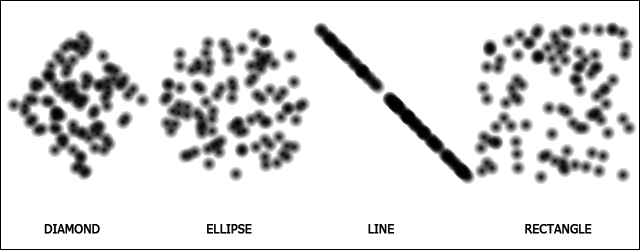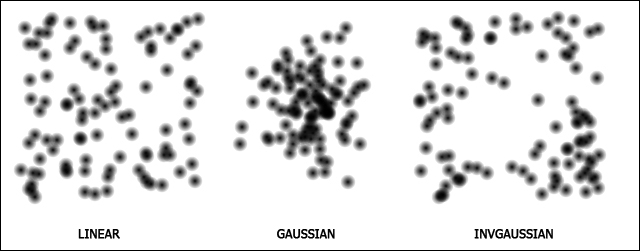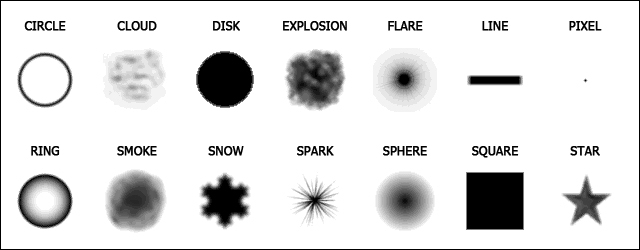Over the last two chapters we have built a robust physics-based game utilizing Joints, Fixtures, and Forces. We then added a full Front End that had a shop where the player could purchase equipment and unlockable levels. We also updated the HUD and implemented the Introductory and Score screens to round out each level. It feels almost like a complete game, but something is missing. The TNT blinks out of existence and the breaking of the Pillars just pops into view. In this chapter, we are going to solve this by adding a few particle effects to the game to help mask these changes. After this little bit of polish, our game will be ready for release!
Particle effects are the decorative flourishes used in games to represent dynamic and complex phenomena, such as fire, smoke, and rain. To create a particle effect, it requires three elements: a System, Emitters, and the Particles themselves.
Particle systems are the universe in which the particles and emitters live. Much like the universe, we cannot define the size but we can define a point of origin which all emitters and particles will be placed relative to. We can also have multiple particle systems in existence at any given time, which can be set to draw the particles at different depths. While we can have as many particle systems as we want, it is best to have as few as possible in order to prevent possible memory leaks. The reason for this is that once a particle system is created, it will remain in existence forever unless it is manually destroyed. Destroying the instance that spawned it or changing rooms will not remove the system, so make sure it is removed when it is no longer needed. By destroying a particle system, it will remove all the emitters and particles in that system along with it.
Particle emitters are defined areas within a system from which particles will spawn. There are two types of emitters to choose from: Burst emitters that spawn particles a single time, and Stream emitters that spew particles continuously over time. We can define the size and shape of the region in space for each emitter, as well as how the particles should be distributed within the region.

When defining the region in space, there are four Shape options : DIAMOND, ELLIPSE, LINE, and RECTANGLE. An example of each can be seen in the preceding diagram, all using exactly the same dimensions, amount of particles, and distribution. While there is no functional difference between using any one of these shapes, the effect itself can benefit from a properly chosen shape. For example, only a LINE can make an effect appear to be angled 30 degrees.

The distribution of the particles can also affect how the particles are expelled from the emitter. As can be seen in the preceding diagram, there are three different distributions. LINEAR will spawn particles with an equal random distribution throughout the emitter region. GAUSSIAN will spawn particles more towards the center of the region. INVGAUSSIAN is the inverse of GAUSSIAN, wherein the particles will spawn closer to the edges of the emitter.
Particles are the graphic resources that are spawned from the emitters. There are two types of particles that can be created: Shapes and Sprites. Shapes are the collection of 64 x 64 pixel sprites that comes built-in with GameMaker: Studio for use as particles. The shapes, as seen in the next diagram, are suitable for the majority of the most common effects, such as fireworks and flames. When wanting to create something more specialized for a game, we can use any Sprite in the Resource tree.

There are a lot of things we can do with particles by adjusting the many attributes available. We can define ranges for how long it lives, the color it should be, and how it moves. We can even spawn more particles at the point of death for each particle. There are, however, some things that we cannot do. In order to keep the graphics processing costs low, there is no ability to manipulate individual particles within an effect. Also, particles cannot interact with objects in any way, so there is no way to know if a particle has collided with an instance in the world. If we need this kind of control, we need to build objects instead.
Note
Designing the look of a particle event is generally a trial and error process that can take a very long time. To speed things up, try using one of the many particle effect generators available on the Internet, such as Particle Designer 2.5 by Alert Games found here: http://alertgames.net/index.php?page=s/pd2.
Using particle effects can really improve the visual quality of a game, but when developing a game intended to be played in a browser we need to be careful. Before implementing a particle effect, it is important to understand potential problems we may encounter. The biggest issue surrounding particles is that in order for them to be rendered smoothly without any lag, they need to be rendered with the graphics processor instead of the main CPU. Most browsers allow this to happen through a JavaScript API called WebGL . It is not, however, an HTML5 standard and Microsoft has stated that they have no plans for Internet Explorer to support it for the foreseeable future. This means a potentially significant portion of the game's potential audience could suffer poor gameplay if particles are used. Additionally, even with WebGL enabled, the functionality for particles to have additive blending and advanced color blending cannot be used, as none of the browsers currently support this feature. Now that we know this we are ready to make some effects!
